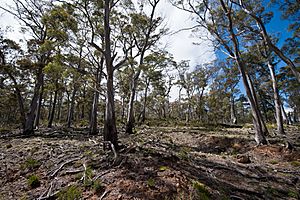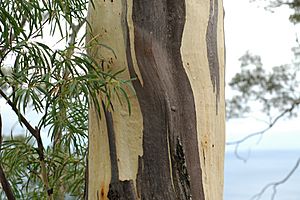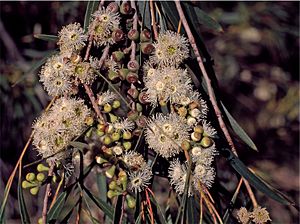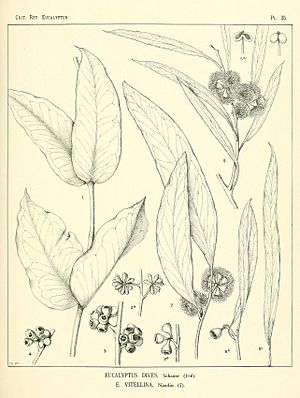White peppermint facts for kids
Quick facts for kids White peppermint |
|
|---|---|
 |
|
| Eucalyptus pulchella grassy woodland | |
| Scientific classification | |
| Genus: |
Eucalyptus
|
| Species: |
pulchella
|
| Synonyms | |
|
|
The white peppermint or narrow-leaved peppermint (scientific name: Eucalyptus pulchella) is a type of small to medium-sized tree. It is found only in Tasmania, an island state of Australia. This tree has smooth bark, though older trees might have some rough, stringy bark. Its leaves are long and thin. The flowers grow in groups of nine to twenty or more and are white. After flowering, it produces cup-shaped fruits.
Contents
What Does the White Peppermint Look Like?
The white peppermint is a straight tree that can grow up to 20 meters (about 65 feet) tall. It has a special woody swelling at its base called a lignotuber. This helps the tree regrow after damage, like a fire.
Bark and Leaves
The bark is usually smooth and white or light grey. On older trees, the lower part of the trunk might have rough, greyish bark. Young plants and new shoots have narrow, spear-shaped leaves. These leaves are about 20-35 mm long and 2-4 mm wide.
Adult leaves are shiny dark green on both sides. They are thin, about 33-120 mm long and 3-10 mm wide. Each leaf narrows down to a short stalk called a petiole, which is 2-10 mm long.
Flowers and Fruit
The flower buds grow in groups of nine to twenty or more. They are found where the leaves meet the stem. These groups of buds are on a small stalk, 2-8 mm long. Each individual bud has its own tiny stalk, 2-5 mm long.
Mature buds are oval or club-shaped, about 3-6 mm long and 2-3 mm wide. They have a rounded cap called an operculum. The white flowers bloom from November to March. After flowering, the tree produces woody, cup-shaped fruits. These fruits are about 4-6 mm long and 5-7 mm wide. They are a type of capsule, which means they open to release seeds.
Naming the White Peppermint
The scientific name Eucalyptus pulchella was first officially described in 1829. A botanist named René Louiche Desfontaines wrote about it in his book.
Meaning of the Name
The word pulchella comes from Latin and means "beautiful." The common name, white peppermint, describes its smooth, white trunk. It also refers to the peppermint-like smell of its crushed leaves.
Where Does the White Peppermint Grow?
The white peppermint tree is found only in the lowlands of south-east Tasmania. It grows on rolling, hilly land, usually between 100 and 500 meters (330-1640 feet) above sea level.
Preferred Environment
The direction a slope faces (its aspect), the type of soil, and how well water drains are all important for where this tree grows. It likes the upper parts of north-west facing slopes. These slopes have shallow soils over a type of rock called Jurassic dolerite.
These ridgetops often have limited water because the soil is shallow and the rock holds water tightly. North-west facing slopes also get a lot of sun, which makes them dry. The white peppermint can handle these dry conditions and even short periods of drought. This is why it grows well on these dry, rocky ridgetops.
Forest Communities
E. pulchella is often the main tree in dry sclerophyll open forests and woodlands. These forests are open and usually don't grow taller than 25 meters (82 feet). The ground is often covered by native grasses and plants like Lomandra longifolia. There are usually not many shrubs.
Sometimes, E. pulchella grows with other types of eucalypts. These include E. globulus, E. viminalis, and E. rubida.
Life Cycle and Ecology
Like many plants in the Myrtaceae family (which includes eucalypts), the white peppermint needs fire to complete its life cycle.
Fire and Regeneration
Eucalyptus seeds are kept in tough, woody capsules. These capsules often stay on the tree for several years after the seeds are ready. A fire is needed to dry out and open these capsules, releasing the seeds. Fire also creates a special "ashbed" on the ground. This ashbed is rich in nutrients and helps new eucalypt seedlings grow by clearing out other plants.
Eucalypt trees are actually good at promoting fires. Their bark and fallen leaves are very flammable. The oils in their leaves also help fires spread. This means dry eucalypt forests often have fires about every 20 years.
Eucalypts can also regrow after a fire without seeds. They can sprout new shoots from their lignotuber (the woody base) or from special buds under their bark called epicormic buds.
Pollination
Eucalyptus trees usually need animals to move their pollen between flowers to make seeds. Their pollen is not easily carried by wind. Birds and insects are common pollinators. They are attracted to the flowers by a sweet liquid called nectar. Birds often visit flowers that are close together, helping to spread pollen nearby. E. pulchella flowers a lot for about two months during summer, with the most flowers appearing around November.
Seed Dispersal
The seeds of Eucalyptus are stored in woody capsules. These capsules open up through small openings called valves once they dry out. The capsules can stay on the tree for several years. Most seeds are released after a fire or during very hot weather.
Seeds usually fall within one tree height from the base of the tree. Once they hit the ground, they don't move much, except sometimes ants might carry them away.




